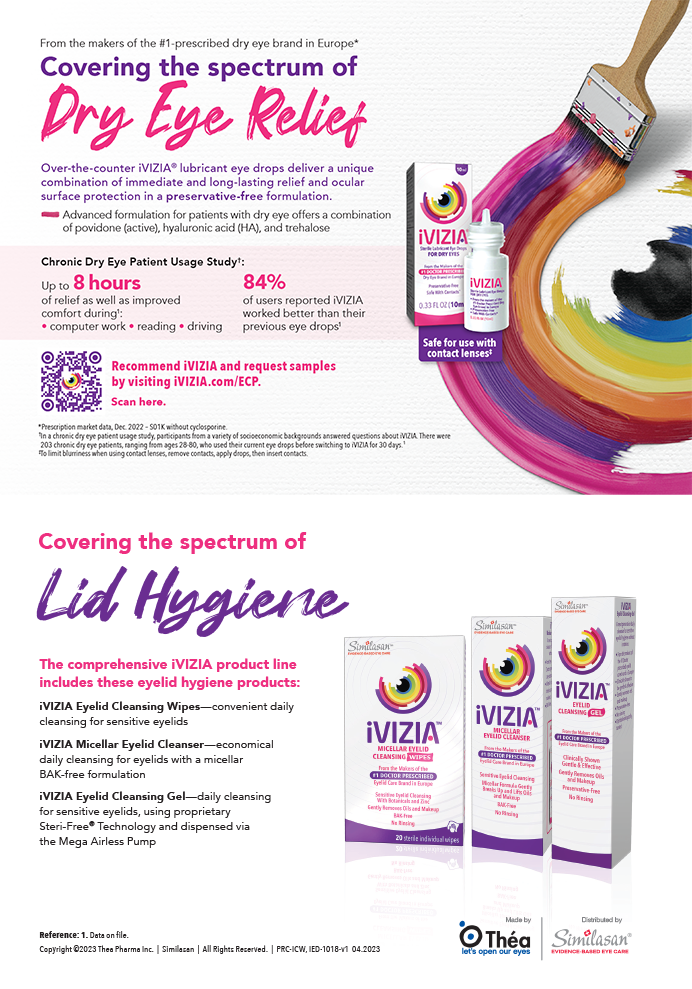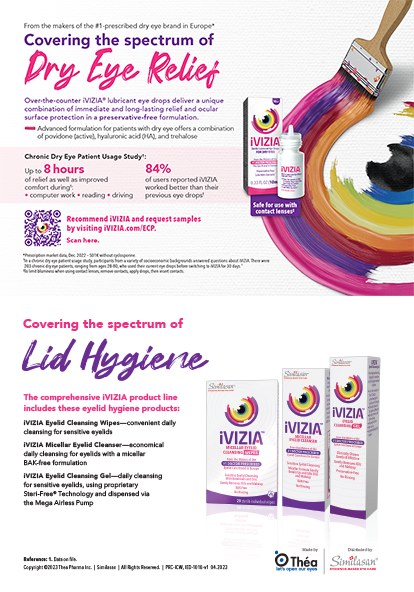You are about to examine Mr. Jones 1 week after implanting a presbyopia-correcting IOL. A technician stops you outside the door and says, "I just wanted to let you know that Mr. Jones is very frustrated with his vision. He thought it would be better after his cataract surgery." His UCVA is 20/40, and his refraction is -1.25 D sphere.
Refractive surprises after cataract surgery are fortunately rare these days, but surgeons who implant premium IOLs should be equipped to deal with such events. Even though an IOL exchange or a piggyback IOL are certainly viable means of addressing residual refractive error, there is a strong argument for treating low residual refractive errors after cataract surgery with extraocular methods. Although residual astigmatism of up to 1.50 D may often be effectively reduced with limbal relaxing incisions, higher levels of cylinder and any spherical correction require laser vision correction or an IOL exchange. A return trip to the ambulatory surgery center or the OR for an IOL exchange is stressful for both the patient and surgeon. It is also potentially quite costly, particularly if the patient paid out of pocket for a refractive lens exchange that is not covered by insurance. Whereas the thought of learning and mastering LASIK surgery may be daunting to even seasoned cataract surgeons, surface ablation with PRK is a simple and powerful way to adjust postoperative refractive errors in cataract patients in an office setting. The literature is replete with articles touting the benefits of LASEK (using ethanol to mobilize a sheet of epithelium, which is then replaced after ablation) or epi-LASIK (using a modified microkeratome to create an epithelial sheet, which is then replaced). PRK is a simpler technique with equivalent efficacy to LASIK and is much more user friendly to a new refractive surgeon, as long as he or she masters and adheres to the following basic principles.
COUNSEL PATIENTS BEFORE IOL SURGERY
Surgeons need to advise patients before premium IOL surgery that they may have to undergo a PRK enhancement that will delay their visual recovery. When planning premium IOL surgery in which the primary goal is good visual function without spectacle correction, I determine ahead of time whether patients are candidates for a PRK enhancement. If so, I inform them that I may be able to enhance their results with laser vision correction. Otherwise, I inform them that an IOL exchange may be the only surgical option for residual spherical error. Although most patients are not overly worried about the risks of intraocular manipulation during cataract surgery, many are reassured to know that the result of their surgery can be adjusted without a return to the OR.
Some patients may ask about undergoing LASIK instead of PRK. Although I will consider LASIK for some individuals, many older patients have poorly adherent corneal epithelium and are less likely to sustain an operative complication with surface ablation. PRK severs fewer corneal nerves than LASIK, so it is less likely to reduce corneal sensitivity and contribute to postoperative dry eye. In addition, older patients (ie, over 65 years old) are more prone to vascular disease, which increases the (still unlikely) possibility that the prolonged suction required during LASIK surgery could precipitate a retinal vascular event. I therefore use surface ablation for most elderly patients who require laser vision correction after cataract surgery.
ALLOW THE REFRACTIVE ERROR AND BCVA TO STABILIZE
An observation period is especially important if the patient has had prior refractive surgery, because fluctuations in corneal shape and hence refractive error may continue for a longer period of time. Under- or overcorrection is readily evident 1 to 2 weeks postoperatively in an eye that has never undergone refractive surgery before, but eyes that had prior LASIK, PRK, or RK may take longer to stabilize. If the patient has more than 3.00 D of unintended residual myopia or 2.00 D of hyperopia, he or she should undergo an IOL exchange within the first postoperative month whenever possible. For PRK enhancement after IOL surgery, it is not necessary to wait 3 to 6 months as one might before enhancing the result of prior PRK or LASIK; 6 to 8 weeks is usually sufficient. Surgeons should prescribe spectacles if patients need them postoperatively. If the unintended refractive error is less than 2.00 D, anisometropia should be tolerable. If the patient does not achieve the expected correction, surgeons should look for (and treat) other causes of decreased BCVA that may distort the refraction (eg, cystoid macular edema).
VERIFY THAT THE TOPOGRAPHY CORRELATES WITH THE REFRACTIVE ERROR
Although most patients have some degree of orthogonal, regular corneal astigmatism before and after surgery (Figure 1A), those who experience epithelial sloughing during cataract surgery can develop irregularities in the epithelial surface that manifest as increased refractive astigmatism, as can patients with keratoconus (Figure 1B). To correct astigmatism in eyes with intraoperative epithelial sloughing, superficial keratectomy (epithelial debridement) is preferable to PRK or limbal relaxing incisions. If the corneal topography appears to be normal and unexplained astigmatism is still present, the surgeon should examine the IOL for evidence of tilt or decentration. If the IOL's position is in doubt based on the slit-lamp examination, imaging with optical coherence tomography using a device such as the Pentacam (Oculus, Inc., Lynnwood, WA) or anterior segment optical coherence tomography can be helpful.
CONSIDER YAG LASER CAPSULOTOMY BEFORE PRK
If the subjective visual acuity endpoint is not distinct with manifest refraction, YAG capsulotomy often allows for the refinement of a consistent refraction with which to plan a PRK enhancement. If the patient has been implanted with the Crystalens (Bausch & Lomb, Rochester, NY), it is advisable for surgeons to perform the capsulotomy prior to any refractive surgery because the effective lens position may shift.
MANAGE THE SURFACE
Ocular surface instability from dry eye and/or lipid tear deficiency from meibomitis frequently causes refractive instability after cataract surgery, especially in patients with multifocal IOLs. Eyelid hygiene, Restasis (cyclosporine ophthalmic emulsion 0.05%; Allergan, Inc., Irvine, CA), artificial tear supplements, and punctal occlusion are all valuable treatments in this situation, and surgeons should use them aggressively to optimize lubrication before making a decision about a PRK enhancement. Ocular rosacea is common, and consideration should be given to the use of adjunctive oral tetracyclines to improve meibomian gland function before surgery in these patients.
Good ocular surface lubrication is essential during the post-PRK healing process. I prescribe preservative-free artificial tears b.i.d. to q.i.d. after the first postoperative week, and as noted earlier, have a low threshold for the placement of permanent punctal plugs and the initiation of Restasis therapy. If Restasis was in use before surgery, I recommend stopping it until topical antibiotics are discontinued.
CHOOSE THE PROPER POSTOPERATIVE MEDICAL THERAPY AFTER PRK
Fitting a bandage contact lens after PRK is very important for the patient's comfort and ensuring prompt healing of the corneal epithelium. I place collagen punctal plugs in all PRK patients to enhance ocular surface lubrication and maintain hydration of the bandage contact lens, which I soak in a fourth-generation fluoroquinolone solution such as Vigamox (Alcon Laboratories, Inc., Fort Worth, TX) or Zymar (Allergan, Inc.). We prefer to place an extended wear lens with high oxygen permeability, such as the O2Optix (CIBA Vision, Duluth, GA) with a base curve of 8.6 mm and a diameter of 14.2 mm. For steeper corneas (46.00 D and up), the Soflens 66 Steep/Medium lens (Bausch & Lomb, Rochester, NY) is my bandage contact lens of choice. The lens should fit snugly but not be overly tight. On the day after PRK, an optimally fit bandage contact lens should move slightly (0.25 mm) with blinking or be movable with gentle upward digital pressure on the lower eyelid.
Medical therapy after PRK consists of topical antibiotic prophylaxis as well as anti-inflammatory therapy with topical steroids and nonsteroidal anti-inflammatory drugs (NSAIDs). Patients use a forth-generation fluoroquinolone solution and prednisolone acetate 1% suspension q.i.d. for 1 week, at which time the epithelium is healed, and the bandage contact lens has been removed (generally postoperative day 4 for myopes and day 5 for hyperopes). After 1 week, antibiotics are discontinued, and topical steroids are tapered by one drop per day every 2 weeks during a 6-week period.
If MMC is used during surgery, steroids are reduced to b.i.d. at 1 week and continued at that dose for 6 weeks.
A topical NSAID is very helpful for controlling pain but can impede epithelial healing and incite sterile corneal stromal inflammation in some patients if continued for too long, so we generally prescribe NSAIDs only for 24 hours. Acular LS (Allergan, Inc.) and Nevanac (Alcon Laboratories, Inc.) can be used t.i.d. or q.i.d., whereas Xibrom (Ista Pharmaceuticals, Inc., Irvine, CA) should be used only b.i.d.
Oral analgesia after PRK is also important for patients' comfort. If there are no medical contraindications, oral NSAID therapy with higher doses of ibuprofen (600 to 800 mg b.i.d.) or naproxen sodium (440 mg b.i.d.) is helpful and can minimize the need for stronger medications.
COUNSEL PATIENTS ABOUT VISUAL RECOVERY AFTER PRK
Patients undergoing PRK often have the misguided idea that they will see well immediately, as they are likely to know someone who has undergone LASIK surgery. My colleagues and I counsel all of our patients that their vision will fluctuate greatly for the first 4 to 6 days until the bandage contact lens is removed and that full recovery may take 4 weeks or longer. Most patients achieve functional vision in the 20/30 to 20/50 range within days of the bandage contact lens' removal. If they are aware that visual recovery is a process, patients tend to be accepting of this fact.
TAKE A CERTIFICATION COURSE AND FIND A MENTOR
Surgeons who are learning a new procedure need to take the time to attend meetings and to find a colleague who will teach them how to achieve the best results. Learning how to perform PRK surgery is not difficult and does not require a refractive surgery fellowship, but surgeons will likely need to become certified by a clinical trainer for one of the excimer laser manufacturers.
In addition to learning how to use the laser and associated diagnostic technology such as wavefront analyzers (although wavefront-guided enhancements for small corrections after cataract surgery are probably unnecessary in most cases), surgeons must become familiar with many details that can enhance postoperative results. This training will make the procedure and the postoperative course easier and safer for patients. Many refractive surgery practices are willing to allow occasional users to perform surface ablation and help them become skilled in the managing these cases, specifically if outside users support them in other ways, such as by referring patients outside their particular area of expertise. In general, it is important for surgeons to be comfortable with techniques for epithelial removal1-3 (eg, dilute ethanol or mechanical brush) (Figure 2) during surgery and strategies to optimize the management of postoperative pain.4 Many refractive surgeons now use a single intraoperative dose of MMC5 routinely during PRK surgery (Figure 3), especially for eyes that have undergone prior LASIK or RK.6 MMC is not necessary for eyes undergoing treatment for small corrections, as discussed earlier, but surgeons will need to be comfortable using this drug if they plan to treat eyes that underwent prior corneal surgery.
IN SUMMARY
Surgeons who add PRK to their surgical armamentarium will greatly expand their ability to fine-tune residual refractive errors after IOL surgery. Patients will appreciate receiving all of their care from their treating cataract surgeon, which makes it well worth the effort to add this important skill to the premium IOL practice.
Jonathan H. Talamo, MD, is the founder of Talamo Laser Eye Consultants in Waltham, Massachusetts, and is an associate clinical professor of ophthalmology at Harvard Medical School in Boston. He is a member of the speakers' bureau for Alcon Laboratories, Inc.; Allergan, Inc.; and Inspire Pharmaceuticals, Inc. Dr. Talamo may be reached at (781) 890-1023; jtalamo@lasikof boston.com.


